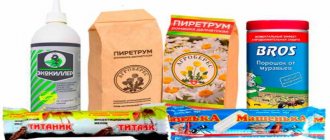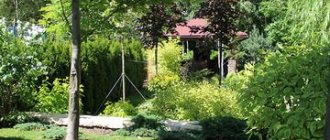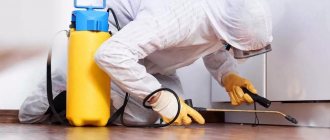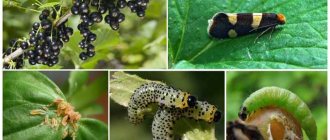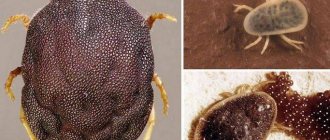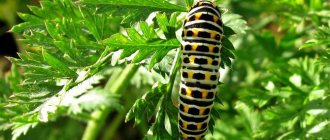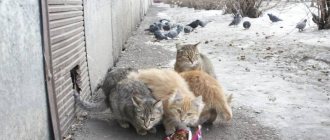Feeding features of the house wasp
Wasps can be described as almost omnivorous creatures, and this is the main difference between them and bees. However, there are many nuances in their way of eating and diet. The larvae can feed exclusively on animal food - other insects. It follows that the younger generation can be of great benefit to gardeners by helping to destroy crop pests. The diet of wasps includes:
- Insects and their larvae;
- Meat;
- Fish;
- Fruits;
- Nectar of flowers;
- Syrup.
The food preferences of wasps vary greatly depending on their stage of development. The scientific explanation for this fact is to exclude competition for a food source between individuals of the same species at different life stages.
Diet
Harmless and sluggish-looking wasp larvae are insectivores. They themselves are not able to hunt and get their own food, but they willingly eat parts of insects that are delivered to them by adults.
Depending on the species, there are differences between individuals:
- feed themselves;
- feed on social wasps.
The larvae of European and Asian hornets cannot feed without the help of adults and cannot actively move inside the nest. They only slightly rotate their heads looking out of the honeycomb. The diet of adult insects includes flower nectar, sweet berry and fruit juice. And the younger generation prefers animal food, which is chewed for them by wasps and delivered directly to the nest. The excrement remains inside the cocoon until it completely transforms into an adult insect. Having spread its wings, the young individual leaves the nest, and the workers remove the secretions.
Advice
Homeowners can sometimes have a hard time spotting a wasp nest. When searching, keep in mind that the colony can settle inside walls and even under floorboards.
After the autumn fertilization of the female, wild male wasps die. In the vast majority of cases, females prepare small nests in the form of a depression in the ground or a paper shelter that is attached to walls or trees. The adult attacks and paralyzes any insect with poison and delivers it to its shelter. This is where the wasp egg is laid. After hatching, the individual begins to feed on insects. She does this in such a way that the “food” remains viable for a long time.
What does a wasp larva eat:
- caterpillars;
- butterflies;
- cockroaches;
- slugs;
- bees;
- spiders;
- little mice;
- small lizards.
Each species prefers different types of insects for laying eggs. Some eat only spiders, others like bedbugs. Some wasps lay eggs directly into a living insect. As the larvae mature, they eat their prey from the inside. Over time, the insect dies, and the young, fully formed individual climbs out.
What do adults eat?
The diet of wasps is quite varied. Insects prefer fruit and berry juices and fruit pulp. Among their favorite fruits are raspberries, plums, apricots, strawberries, and grapes. Wasps try to avoid harder fruits whenever possible. Adults are very attracted to overripe fruits that have begun to ferment. Syrup, honey, jam and sugar are among the favorite products of winged sweet tooths. Wet sugar or fresh jam will inevitably attract many wasps into your apartment.
Some representatives of aspens at certain stages of their life cycle give preference to the young of various beetles, as well as some species of wasps. These predators are capable of exterminating even larger insects and can successfully hunt spiders of impressive size.
While feeding their larvae, adults hunt other insects and feed them chewed to their offspring. In the process of chewing the prey, the predator also consumes some of its hemolymph. Hemolymph is rich in protein and replenishes the energy reserves of the imago. Directly in the process of feeding and transferring food to the larva, the adult insect receives some of the saliva of the offspring, from where it takes the necessary substances for normal life. However, despite this, plant foods and sweets are preferable for imagoes. A danger to people is represented by wasps that appear out of nowhere in the apartment, flying to the aroma of food.
Where do wasps nest?
The young queen chooses a place where there is building material and food supplies in close proximity. In the wild, insects make their homes on trees with a large, dense crown, under old stumps, and abandoned bird houses. However, there are cases of a hive being built under a stone, on a blade of grass. Where the young female considers it necessary to build housing, the working individuals will continue the construction.
Insects can build hives near humans - under the roof of a house, outbuildings, in an attic, on a balcony, or live in a garden, yard, vegetable garden, or vineyard. And also on trees, bushes, old stumps on the site. If in the wild, wasps bring a lot of benefits, destroying harmful insects, in the territory of a garden, summer cottage, yard, they become real pests. Therefore, a person tries to get rid of wasp nests on a balcony, in a country house, or in a vineyard.
On a note!
It's very easy to anger a wasp. A few sharp movements are enough for her to rush to attack. During an attack, it makes special sounds - signals, warns other members of society about the danger, and also calls for help. If there is a nest nearby, a whole swarm can attack a person.
Nutrition of larvae
Wasps in the larval stage are insectivorous. According to the type of feeding, the larvae are divided into 2 groups: those that parasitize the eggs and larvae of beetles, and those that eat chewed insects of various types. The well-known paper wasps and hornets feed their offspring, which are not able to feed on their own. The larvae are unable to move, they only move their heads. The main food of young animals consists of the following insects:
- Butterflies;
- Bedbugs;
- Caterpillars;
- Slugs;
- Spiders;
- Cockroaches.
When living in close proximity to an apiary, the striped pest will hunt bees in order to feed them to the young. Such large representatives of wasps as hornets are distinguished by their ability to successfully hunt even lizards and mice. Single species of wasps have a less varied diet. Some of them feed exclusively on bedbugs, others on the larvae of certain beetles.
Some species of wasps are characterized by pronounced parasitism. Females climb into the home of other wasps and lay eggs directly on the larvae. It is worth paying special attention to some surprising eating habits of scoliic wasps. Insects do not build nests to raise their young. They lay eggs on prey that has been previously immobilized by poison. Eggs develop on this insect, and when they emerge, the larvae feed on the victim.
Meat and fish are of great interest to wasps, but only as food for the larvae. Adults carry small bitten pieces into the nest and feed them to the offspring, after chewing them first. Both carrion in the forest and fresh meat products at the market are suitable for them. Wasps can appear in the house as soon as they smell the meat smell.
Reproduction of wasps
At the end of summer, workers attach large honeycombs to the nest. The queen lays her eggs there. After 20 days, young fertile females will appear, males - drones. For some time the young generation stays in the nest, feeds, and gains strength. They fly out at the end of August. Wasps mate in late summer, early autumn. Once is enough for the queen to lay eggs for the rest of her life.
The old swarm dies with the onset of the first frost. The young queen, after a successful winter, begins to build a nest and reproduce eggs. Throughout the warm season, mainly working individuals appear; only in August do fertile females and males appear. During the mating season, wasps are especially active and aggressive. If a person accidentally approaches the nest, the entire swarm attacks. Therefore, at the end of summer you need to be especially careful in nature.
Life of wasps
Interesting!
In countries with warm climates, social wasps live for several years, the family numbers several thousand individuals, and the nest reaches 60 cm in diameter. Some queens prefer not to build their own nest, but to conquer it. She sneaks into someone else's hive, kills the queen, and takes her place herself. Over time, only her offspring remain to live in the nest.
Vegetarian wasps
Some species of wasps do not show the slightest interest in meat and fish, as well as in insects as a source of food for themselves or their young. A striking example is the flower wasp, whose diet consists exclusively of flower nectar, regardless of the stage of development. Adults collect nectar from flowers and also store it in their home for their offspring. Other species are very similar to bees in their lifestyle and feeding method - they create reserves of honey.
There are also special types of wasps belonging to the intermediate type. They are in the middle between insects that eat other insects, and radically different from them - they collect and store honey. It is difficult to determine by external signs which representative of the wasp tribe is a vegetarian and which is an omnivore or a parasite. Outwardly, they are very similar, and for the most part have a classic black and yellow color.
Nutrition
Wasps are predators, but they don’t shy away from sweets, on the contrary, they adore them. Almost everyone knows that if you leave a bowl of honey or jam on the open veranda, then after a while you can find a whole flock of feeding wasps near it.
These insects collect flower nectar, but, being predators, they also eat small relatives of other species.
The predatory nature of wasps is also manifested in the fact that in order to provide their larvae with food, they can lay eggs, for example, in a large caterpillar.
The wasp pierces the skin of the caterpillar, using its ovipositor like a scalpel, lays eggs and the larvae, having hatched, begin to eat the body of the victim. Spiders, large beetles, and cicadas become such incubators.
Fighting wasps on the site
Before fighting striped predators, you need to find out - is this really necessary? The benefits of them in the form of pest control are obvious. However, if you find a wasp nest in your home, you need to think about a way to eliminate the potential danger.
Wasp traps containing bait are very effective. Considering the food preferences of these insects, it is advisable to use beer, kvass, and fermented fruits. Many gardeners and farmers prefer not to destroy wasps, but use products to protect ripening fruits from pests, in the form of net covers.
Wasps are frequent guests in a private home. They live in close proximity to homes, hunting other insects in gardens or vegetable gardens, and may well fly into a house at the smell of food. If war is declared on these pests, you must take every precaution to avoid exposing yourself, your family, and your pets to them.
Appearance of wasp larvae and methods of getting rid of them
Any insects are a nuisance for the owners of the house in which they appear, be it house ants, cockroaches or wasps. Wasps are common inhabitants of human homes, gardens or plots. Larvae are offspring that will bring with them even more larvae and harm, so it is extremely important to know what wasp larvae look like and effective ways to destroy them.
These insects can cause dangerous intestinal infections; they behave aggressively if someone tries to influence their nest. Wasps also spoil food and disturb owners with their buzzing and general presence in the apartment. Hundreds of people around the world also die every year from allergic reactions to bee stings.
Appearance of larvae and stages of their development
These insects are among those that go through the cycle of becoming adults during their lives. The female lays a small larva, equal to about a third of the size of the adult. The embryo turns into a pupa, which quickly undergoes the process of forming internal organs: the digestive system and other systems vital for insects.
After a few days, the insect sheds its shell and becomes an adult. What do wasps feed their larvae? During the period of its “growing up”, a small insect cannot eat the same food as older individuals; the female obtains protein “products” for her offspring: spiders, ants, midges and other insects. The mother attacks her prey, rendering it paralyzed, and brings it to the nest.
Stages of wasp development
The newly laid pupa is almost motionless, so the adult wasp takes care of it. The wasp larva has a yellow body; it does not have membranous and developed wings or legs, with the help of which the flying pest can capture prey and hold it. Since wasp larvae spend most of their development period in honeycombs, they do not move, and if they fall out of the shelter, they move crawling, like caterpillars, only wriggling and rolling from side to side due to the lack of limbs. The larvae have a round body on which divisions are visible
The wasp lays its offspring in honeycombs, attaching the larvae to the walls; it seals the entrance to the “cell” with a special compound so that the “baby” does not fall out. Over time, the wasp larvae reach such a size that they no longer fit into the honeycomb, so it is difficult to fall out of it.
Where to look for a wasp's nest?
The most common location for a nest in an apartment is a balcony, under the ceiling in a corner, behind shelves, under the trim, or vice versa - in a corner closer to the floor, under a window sill, on pipes.
In a private house, wasps can fly from attics, from under the roof of buildings, from piles of old things. Wasps often create their nests where they are most difficult to find. To know how to get rid of pupae of flying pests, you should know what wasp larvae look like so as not to confuse them with caterpillars.
Vespiary
Advice: if it is not possible to find a wasp’s home, you just need to put a piece of bread, smeared with jam, melon or meat in the room where they often live and watch their movement. The wasps will quickly smell the treat and fly off to treat themselves, and then fly back, and you can follow them.
Destruction of a nest with larvae
There are quite a lot of means for destroying wasp nests, but since over time the wasps have mutated and become more resistant to the effects of chemical components, a higher concentration of dangerous compounds is added to the substances, which can also harm human health.
Wasp larvae respond well to classic aerosols, for example, Dichlorvos, Raptor, Varana, etc. - they can be found in any grocery store. Such means will not cope with a large spread of insects, but you can easily destroy a small nest located on a balcony, in an apartment, or in the attic. The active ingredients have an enhanced effect indoors.
More effective methods of getting rid of a nest with pupae:
- Pesticides - experts recommend using them if the fight against flying pests has been going on for a long time and is not at all in your favor. The aerosol is sprayed onto the outside of the nest and inside. After 2-3 days, the insects will die, even those that fly into the house for a short time. After this it will be possible to remove the nest;
- Insecticidal dust - you need to generously treat the “entrance” to the home and, just in case, from above. The poison will penetrate inside the house on the bodies of the wasps and have an effect on other individuals, including the larvae. This remedy is good because the insects die without their noticing.
There are also several traditional methods for getting rid of wasps. Experts warn that these methods are used only if the pests have settled in your home for the first time and have not yet multiplied too much.
Home control methods include the following:
- The smell of burnt pine needles - this method of control is suitable for those who do not want to destroy insects and for residents of private houses. If the wasps have settled near the stove, then you need to drown it with pine branches until the wasps fly away. The downside is that this method will not help immediately and is not available to everyone;
- Tree resin - a red thread is treated with resin and stretched from the nest to the fruit tree;
- Foam is a quick and rather ruthless way to completely close the entrance and exit from a home with foam, without leaving a single gap, after which the nest is “cut off” and taken to a safe distance;
- Hot water – the nest must be poured with boiling water and taken out of the home. This method is very risky, since such an attack on the shelter will enrage them, so before carrying out the procedure it is necessary to wear a protective suit;
- Bag - cover the nest with a thick bag, disconnect it from the surface, seal it with tape at the base and burn it. This method requires quick reactions;
- Kerosene – treat the nest with kerosene, after a while the wasps will die and you can get rid of their shelter.
Also see - How to make a wasp trap from a plastic bottle
Conclusion
What do wasp larvae look like to be able to recognize them? They differ little from adult individuals, only they do not have developed legs and wings. But by destroying one larva, you will not be able to get rid of the wasp invasion, so you need to influence the nest itself using folk or chemical methods.

